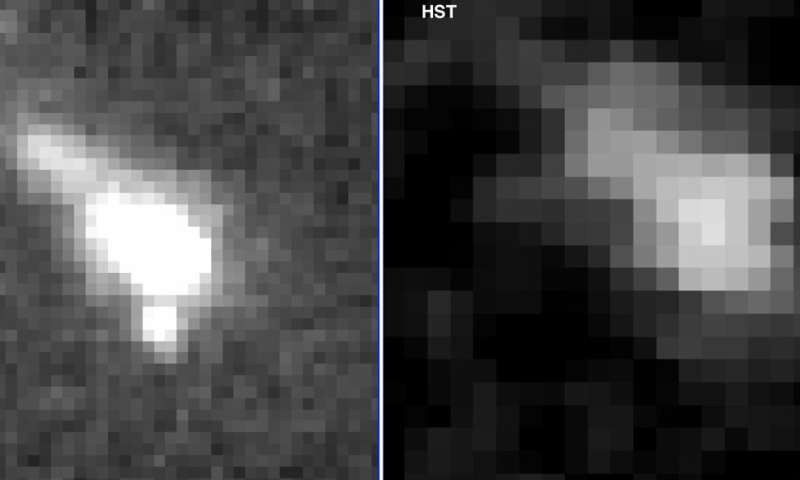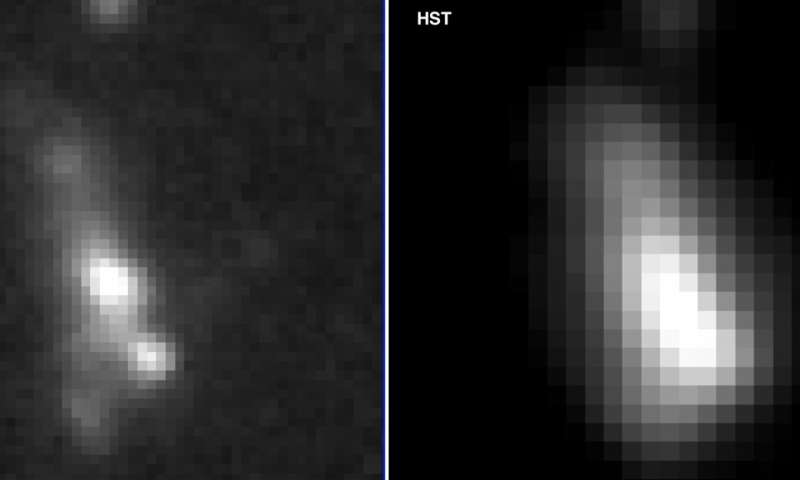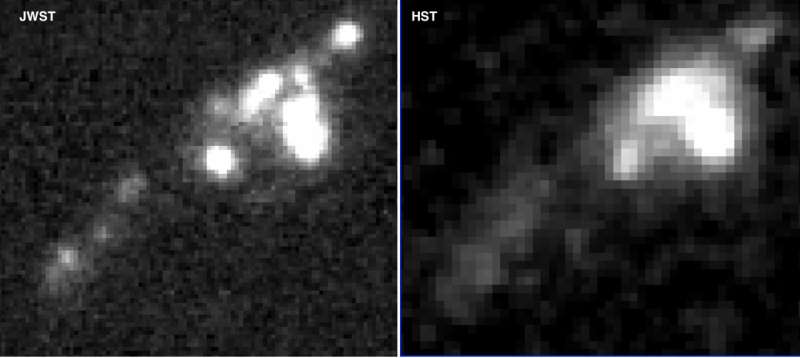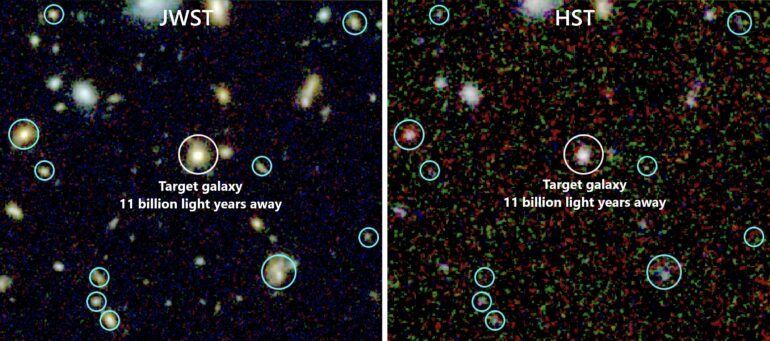New images from the James Webb Space Telescope (JWST) have helped Australian astronomers unlock secrets of how infant galaxies started an explosion of star formation in the very early universe.
Some early galaxies were abundant with a gas that glowed so bright it outshone emerging stars. In research published today, astronomers have now discovered just how prevalent these bright galaxies were some 12 billion years ago.
Images from the JWST have shown that almost 90% of the galaxies in the early universe had this glowing gas, producing so-called “extreme emission line features.”
“The stars in these young galaxies were remarkable, producing just the right amount of radiation to excite the surrounding gas. This gas, in turn, shone even brighter than the stars themselves,” says Dr. Anshu Gupta from the ARC Centre of Excellence for All Sky Astrophysics in 3 Dimensions (ASTRO 3D) and the Curtin University node of the International Centre for Radio Astronomy Research (ICRAR), the lead author of a paper describing the discovery.
“Until now, it was challenging to understand how these galaxies were able to accumulate so much gas. Our findings suggest that each of these galaxies had at least one close neighboring galaxy. The interaction between these galaxies would cause gas to cool and trigger an intense episode of star formation, resulting in this extreme emission feature.”

Images of a distant extreme emission line galaxy. Seen by James Webb Space Telescope (left) and Hubble Space Telescope (right). This comparison highlights the clarity of JWST images. © ARC Centre of Excellence for All Sky Astrophysics in 3 Dimensions (ASTRO 3D)

Images of a distant extreme emission line galaxy. Seen by James Webb Space Telescope (left) and Hubble Space Telescope (right). This comparison highlights the clarity of JWST images. © ARC Centre of Excellence for All Sky Astrophysics in 3 Dimensions (ASTRO 3D)
The discovery is a graphic example of the unparalleled clarity the JWST telescope provides in studying the early universe.
“The data quality from the James Webb telescope is exceptional,” says Dr. Gupta. “It has the depth and resolution needed to see the neighbors and environment around early galaxies from when the universe was only 2 billion years old. With this detail we were able to see a marked difference in the number of neighbors between galaxies with the extreme emission features and those without.”
Previously we struggled to get a clear picture of galaxies from around 2 billion years of the universe’s age. As many stars had yet to form, the task was made more difficult with many fewer galaxies to focus on.
“Prior to JWST, we could only really get a picture of really massive galaxies, most of which are in really dense clusters making them harder to study,” Dr. Gupta says. “With the technology available then, we couldn’t observe 95% of the galaxies we used in this study. The James Webb telescope has revolutionized our work.”

Images of a distant extreme emission line galaxy. Seen by James Webb Space Telescope (left) and Hubble Space Telescope (right). This comparison highlights the clarity of JWST images. © ARC Centre of Excellence for All Sky Astrophysics in 3 Dimensions (ASTRO 3D)
The discovery has proven previous assumptions, says fellow author Associate Professor Tran, ASTRO 3D and the Center of Astrophysics, Harvard and Smithsonian. “We suspected that these extreme galaxies are signposts of intense interactions in the early universe, but only with the sharp eyes of JWST could we confirm our hunch,” she says.
The research relied on data obtained as part of the JWST Advanced Deep Extragalactic Survey (JADES) survey, which is exploring the universe of the earliest galaxies with deep infrared imaging and multi-object spectroscopy. It opens the way for further insights.
“What’s really exciting about this piece is that we see emission line similarities between the very first galaxies to galaxies that formed more recently and are easier to measure. This means we now have more ways to answer questions about the early universe, a period that is technically very hard to study,” says second author, Ravi Jaiswar, a Ph.D. student at Curtin University/ICRAR and ASTRO 3D.
“This research is core to the work of our Galaxy Evolution Program. By understanding what early galaxies look like, we can build on answering questions on the origin of the elements that make up our everything in our everyday life here on Earth,” says Professor Emma Ryan-Weber, Director of ASTRO 3D.
The research is published in The Astrophysical Journal.
More information:
Anshu Gupta et al, MOSEL survey: JWST reveals major mergers/strong interactions drive the extreme emission lines in the early universe, The Astrophysical Journal (2023).
Provided by
ARC Centre of Excellence for All Sky Astrophysics in 3D (ASTRO 3D)
Citation:
New Webb images show gas-rich baby galaxies setting the early universe alight (2023, November 6)
